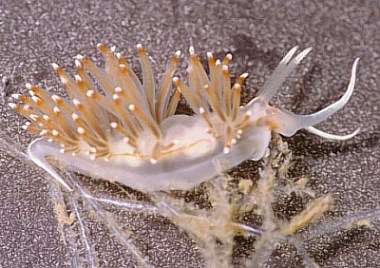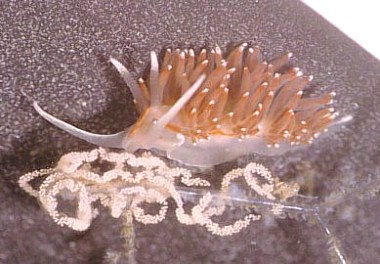Dondice cf. occidentalis from Brasil
June 12, 2000
From: Carlo Magenta-da-Cunha


Dear friends
This specimen is very abundant here. It is found to about 10-12 m deep and I find specimens from 5-30 mm in length. In the region is like swamp area covered with mangroves.
Look to the "...a median red stripe along the head and a stripe along each side...".
Many boats with nets to catch shrimp work in this area. I have samples every week, with specimens dead and alive. My question is how can I make use of these samples? At present I'm only measuring these specimens.
I'm would like some suggestions.
Best Regards!
Magenta
carlomagenta@uol.com.br
Magenta-da-Cunha, C., 2000 (Jun 12) Dondice cf. occidentalis from Brasil. [Message in] Sea Slug Forum. Australian Museum, Sydney. Available from http://www.seaslugforum.net/find/2547Dear Magenta,
Thanks for the photos. It certainly has similarities to Jeff Hamann's photos from Belize, but his animal lacks the orange subapical band on the cerata. I guess in the end it will be a question of comparing the anatomy and colour variation of specimens throughout the geographic range. That is of course easier to say than to do.
Are the coloured lines always this yellow-orange colour or are they sometimes red? Perhaps it is one of those pigments that changes colour when the animal is preserved and that is why it is described as red? Does the colour fade after preservation or does it go a deeper red colour? Formalin may give a different result from alcohol.
Concerning ideas for using the samples for research. If your samples are collected from the fishermen it is a bit difficult to look at aspects of their natural history, although if you collect them over an extended period it could give you an idea of their life cycle if there are distinct size classes or cohorts you can follow. I guess it would be interesting to look at their food but that would be difficult if they and their food are mixed up in the shrimp nets. I note that you have photographed them on an arborescent bryozoan which is possibly Amathia sp? or Zoobotryon sp?. Their food, which I assume is hydroids, is probably tangled up with the bryozoans on the bottom. Another aspect which you could study with your samples is how much colour variation, if any, there is within the population. Are the orange-yellow lines always present? Do they always run the length of the body? What is the pattern of white pigment on the body and tentacles? Are orange bands sometimes present on the cerata? etc. We seldom get a chance to study large populations of a species for such intraspecific variation, and in a species such as this, with a relatively simple colour pattern, recording variation would be quite a simple task.
Hopefully other Forum participants will also have some suggestions on what you could study ,
Best wishes,
Bill Rudman.
Related messages
-
Re: Dondice occidentalis from Massachusetts?
From: Emily Keen, March 18, 2010 -
Dondice occidentalis from Massachusetts?
From: Emily Keen, February 22, 2010 -
Dondice occidentalis from North Carolina
From: Marcel Tanke, October 1, 2009 -
Dondice occidentalis defensive behavior
From: Tony Fernando, November 23, 2006 -
Dondice occidentalis from Florida
From: Jeff Goddard, May 7, 2005 -
Re: Dondice occidentalis feeding
From: Marina Poddubetskaia, March 23, 2004 -
Dondice occidentalis from Bahamas
From: Marina Poddubetskaia, March 22, 2004 -
Dondice occidentalis feeding
From: Marina Poddubetskaia , March 22, 2004 -
Dondice occidentalis from Southern Bahamas
From: Anne DuPont, November 25, 2003 -
Dondice occidentalis with eggs
From: Anne DuPont, November 25, 2003 -
Dondice occidentalis? from Jamaica
From: Ross W. Gundersen, October 20, 2003 -
Re: Mystery aeolid from Florida
From: Anne DuPont , September 27, 2002 -
Mystery aeolid from Florida
From: Anne DuPont, September 20, 2002 -
Dondice occidentalis from Florida
From: Anne DuPont, August 1, 2001 -
Re: Dondice occidentalis from Belize
From: Carlo Magenta-da-Cunha, June 9, 2000 -
Dondice occidentalis from Belize
From: Dave Behrens, November 10, 1999 -
Re: Dondice occidentalis from Colombia
From: Phanor Montoya , October 23, 1999 -
Dondice occidentalis from Colombia
From: Phanor Montoya, October 21, 1999
